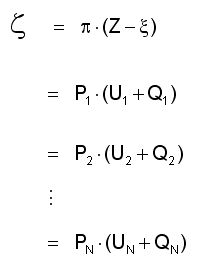As is the case with an output’s price, its marginal cost of production is expressed as the ratio of a financial quantity to a physical quantity. SFEcon’s hyperbolic system of reference has served-up a variable z $/year as the primary descriptor of economic sector’s financial state; and we proceed here to construct the financial discriminant z as the proper numerator for the ratio describing marginal costs. Equation 2-3 defined z in the course of our discussion on the polynomial factoring problem:

Eqa. 2-3
This equation, being confined to an equilibrium upheld by optimality, allows us to directly identify the price pJ of a sector J’s output with its marginal cost of production at its optimal rate of output xJ:

The equation for marginal cost of production can be re-interpreted as supply schedule for good J upon relaxation of the equilibrium context in which it was derived. We merely identify the optimal output rate xJ as an independent variable rate of supply SJ, presume zJ as known and constant, and accept pJ as the dependent price variable PJ. Insofar as our analysis describes a near-optimum, we have a workable estimate of how price varies with supply:

In the case of the household product of leisure time, the marginal cost of production pL is negative: the more a household is at leisure, the less its revenue. This condition is effected in that the ZL of the marginal cost equation is negative and of greater magnitude than xL, which is also negative. The matter is further complicated in that labor’s supply SL is a residual of -xL hours of leisure per year with a labor/leisure sector’s total experience of time tL:

So: constructing a household supply of labor schedule involves 1) equating the wage PL with negative sense of marginal cost of leisure pL, and 2) substituting SL-tL for the x in our generic supply schedule:

Noting that ZL+tL must be a negative quantity, we see PL varies inversely with SL, i.e.: the supply schedule for labor is downward-sloping.